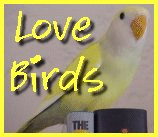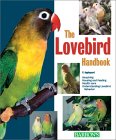Lovebirds
 Origin: African continent (various areas depending on species)
Origin: African continent (various areas depending on species)
For more extensive information on lovebirds visit our Lovebirds Section
| Species
Agapornis roseicollis Agapornis personata personata Agapornis p. fischeri Agapornis p. lilianae Agapornis p. nigrigenis Agapornis taranta Agapornis cana Agapornis pullaria Agapornis swinderniana |
Common Name
Nyasa lovebird Black-cheeked lovebird Red-faced lovebird Black-collared lovebird |
African lovebirds are small parrots that can make delightful pets when hand-fed. The most commonly seen lovebirds in aviculture are the peachfaced, masked, and fischer’s lovebirds. It should be noted that these are distinct species and should not be housed together and especially not bred together. They can be very aggressive toward each other if species are mixed.
Here’s a video of baby lovebirds in the brooder.
The most important thing to remember when deciding on a pet lovebird is the bird should be tame when you purchase it. If the bird is biting or terribly frightened, it has not been handled enough and has not been properly socialized. Sometimes these birds can be tamed down a bit, but many will remain nervous around humans, especially if they were only handled when they were fed with a syringe. Many pet store workers will insist that because the bird is hand fed it will be tame if you work with it for a few days, but generally this can be very frustrating and is only successful in a small number of cases.
Pet lovebirds should be handled regularly to keep them tame. Nibbling with the beak on the fingers or neck should be discouraged at all times, even when it doesn’t hurt as this nibbling can turn to hard bites in a few weeks or months.
Caging: Lovebirds are very active and playful. They should be given as large a cage as possible. Make sure the spacing between bars is no greater than 3/4″ and make sure there are plenty of horizontal bars to facilitate climbing. Add swings and toys to keep your bird amused and content. Cages should be atleast 2 feet long and 18″ wide and high for a lovebird to have adequate room for play and exercise.
Diet: Small hookbill seed mix, cockatiel or parakeet sized pellets (mini or small), fresh vegetables, some fruit, dried figs, corn, sprouts and grains. It is important to insist on a varied diet from the beginning. Lovebirds can be stubborn about dietary changes, but will come around if you put the new food in the cage over and over again for many days or weeks until they try it. Cuttlebone for calcium.
Health: Lovebirds are very robust birds. Like most parrots, they should not be put near drafts (avoid putting the cage near a drafty window, especially at night). They don’t have any tendencies toward obesity. They can occasionally develop feather plucking problems if frustrated and left cagebound for long periods of time.
Noise: Distinctive parrot “chirp”. They sometimes let out short bursts of this chirp. Generally, most people do not find it problematic, making this a good “apartment bird.” If a bird is ignored and bored much of the time, like most parrot species, it will vocalize more to try to get the “flock” to interact with it. Will compete with the television set or other noises at times.
Sleep: Lovebirds should get a good night’s sleep with atleast 10 hours of darkness and quiet. A tv in the room does not equal good sleep.
Sexual behavior: Males will rub the perch and regurgitate. Some people don’t “like” this behavior but it is completely natural. Hens can become protective of the cage when they mature. Avoid giving hens anything that might seem like a nesting area, such as Happy Huts and boxes. If hens lay eggs and become aggressive, cover the cage with a bird-safe cover at night to make sure she is getting adequate dark time, especially in the Spring.
Breeding: Lovebirds are extremely prolific breeders and generally make excellent parents.









